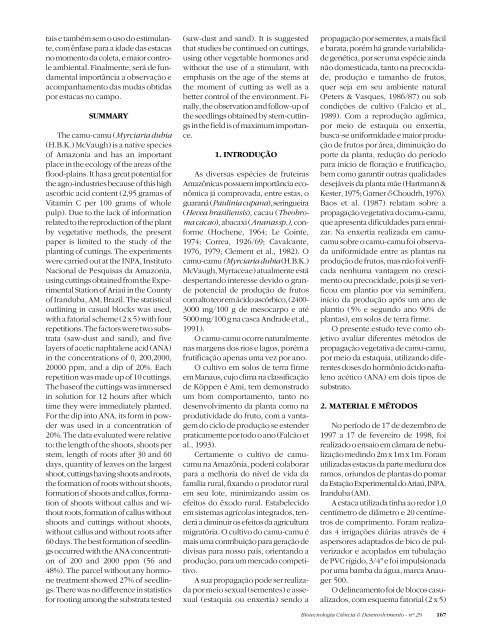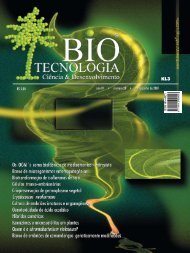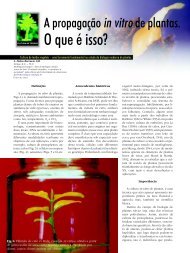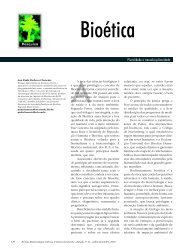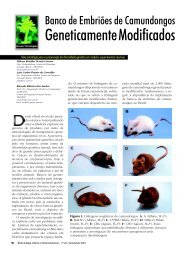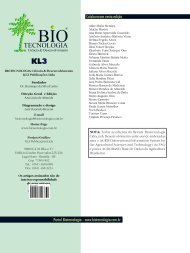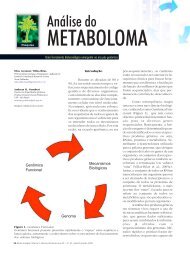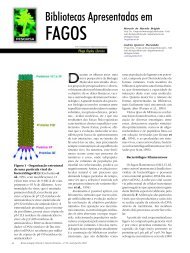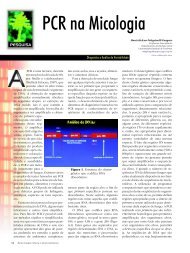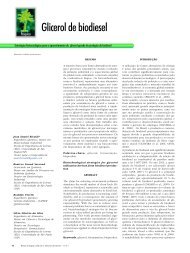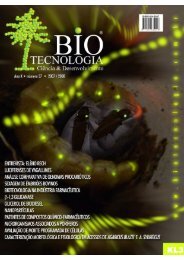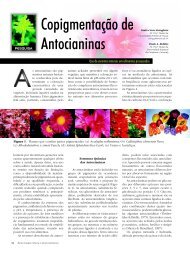Untitled - Biotecnologia
Untitled - Biotecnologia
Untitled - Biotecnologia
You also want an ePaper? Increase the reach of your titles
YUMPU automatically turns print PDFs into web optimized ePapers that Google loves.
tais e também sem o uso do estimulante,<br />
com ênfase para a idade das estacas<br />
no momento da coleta, e maior controle<br />
ambiental. Finalmente, será de fundamental<br />
importância a observação e<br />
acompanhamento das mudas obtidas<br />
por estacas no campo.<br />
SUMMARY<br />
The camu-camu (Myrciaria dubia<br />
(H.B.K.) McVaugh) is a native species<br />
of Amazonia and has an important<br />
place in the ecology of the areas of the<br />
flood-plains. It has a great potential for<br />
the agro-industries because of this high<br />
ascorbic acid content (2,95 gramas of<br />
Vitamin C per 100 grams of whole<br />
pulp). Due to the lack of information<br />
related to the reproduction of the plant<br />
by vegetative methods, the present<br />
paper is limited to the study of the<br />
planting of cuttings. The experiments<br />
were carried out at the INPA, Instituto<br />
Nacional de Pesquisas da Amazonia,<br />
using cuttings obtained from the Experimental<br />
Station of Ariaú in the County<br />
of Iranduba, AM, Brazil. The statistical<br />
outlining in casual blocks was used,<br />
with a fatorial scheme (2 x 5) with four<br />
repetitions. The factors were two substrata<br />
(saw-dust and sand), and five<br />
layers of acetic naphtalene acid (ANA)<br />
in the concentrations of 0, 200,2000,<br />
20000 ppm, and a dip of 20%. Each<br />
repetition was made up of 10 cuttings.<br />
The baseof the cuttings was immersed<br />
in solution for 12 hours after which<br />
time they were immediately planted.<br />
For the dip into ANA, its form in powder<br />
was used in a concentration of<br />
20%. The data evaluated were relative<br />
to: the length of the shoots, shoots per<br />
stem, length of roots after 30 and 60<br />
days, quantity of leaves on the largest<br />
shoot, cuttings having shoots and roots,<br />
the formation of roots without shoots,<br />
formation of shoots and callus, formation<br />
of shoots without callus and without<br />
roots, formation of callus without<br />
shoots and cuttings without shoots,<br />
without callus and without roots after<br />
60 days. The best formation of seedlings<br />
occurred with the ANA concentration<br />
of 200 and 2000 ppm (56 and<br />
48%). The parcel without any hormone<br />
treatment showed 27% of seedlings.<br />
There was no difference in statistics<br />
for rooting among the substrata tested<br />
(saw-dust and sand). It is suggested<br />
that studies be continued on cuttings,<br />
using other vegetable hormones and<br />
without the use of a stimulant, with<br />
emphasis on the age of the stems at<br />
the moment of cutting as well as a<br />
better control of the environment. Finally,<br />
the observation and follow-up of<br />
the seedlings obtained by stem-cuttings<br />
in the field is of maximum importance.<br />
1. INTRODUÇÃO<br />
As diversas espécies de fruteiras<br />
Amazônicas possuem importância econômica<br />
já comprovada, entre estas, o<br />
guaraná(Pauliniacupana),seringueira<br />
(Hevea brasiliensis), cacau (Theobromacacao),<br />
abacaxi (Ananassp.), conforme<br />
(Hochene, 1964; Le Cointe,<br />
1974; Correa, 1926/69; Cavalcante,<br />
1976, 1979; Clement et al., 1982). O<br />
camu-camu (Myrciariadubia (H.B.K.)<br />
McVaugh, Myrtaceae) atualmente está<br />
despertando interesse devido o grande<br />
potencial de produção de frutos<br />
comaltoteoremácidoascórbico,(2400-<br />
3000 mg/100 g de mesocarpo e até<br />
5000 mg/100 g na casca Andrade et al.,<br />
1991).<br />
O camu-camu ocorre naturalmente<br />
nas margens dos rios e lagos, porém a<br />
frutificação apenas uma vez por ano.<br />
O cultivo em solos de terra firme<br />
em Manaus, cujo clima na classificação<br />
de Köppen é Ami, tem demonstrado<br />
um bom comportamento, tanto no<br />
desenvolvimento da planta como na<br />
produtividade do fruto, com a vantagem<br />
do ciclo de produção se estender<br />
praticamente por todo o ano (Falcão et<br />
al., 1993).<br />
Certamente o cultivo de camucamu<br />
na Amazônia, poderá colaborar<br />
para a melhoria do nível de vida da<br />
família rural, fixando o produtor rural<br />
em seu lote, minimizando assim os<br />
efeitos do êxodo rural. Estabelecido<br />
em sistemas agrícolas integrados, tenderá<br />
a diminuir os efeitos da agricultura<br />
migratória. O cultivo do camu-camu é<br />
mais uma contribuição para geração de<br />
divisas para nosso país, orientando a<br />
produção, para um mercado competitivo.<br />
A sua propagação pode ser realizada<br />
por meio sexual (sementes) e assexual<br />
(estaquia ou enxertia) sendo a<br />
propagação por sementes, a mais fácil<br />
e barata, porém há grande variabilidade<br />
genética, por ser uma espécie ainda<br />
não domesticada, tanto na precocidade,<br />
produção e tamanho de frutos,<br />
quer seja em seu ambiente natural<br />
(Peters & Vasques, 1986/87) ou sob<br />
condições de cultivo (Falcão et al.,<br />
1989). Com a reprodução agâmica,<br />
por meio de estaquia ou enxertia,<br />
busca-se uniformidade e maior produção<br />
de frutos por área, diminuição do<br />
porte da planta, redução do período<br />
para início de floração e frutificação,<br />
bem como garantir outras qualidades<br />
desejáveis da planta mãe (Hartmann &<br />
Kester, 1975; Garner &Choudrh, 1976).<br />
Baos et al. (1987) relatam sobre a<br />
propagação vegetativa do camu-camu,<br />
que apresenta dificuldades para enraizar.<br />
Na enxertia realizada em camucamu<br />
sobre o camu-camu foi observada<br />
uniformidade entre as plantas na<br />
produção de frutos, mas não foi verificada<br />
nenhuma vantagem no crescimento<br />
ou precocidade, pois já se verificou<br />
em plantio por via seminífera,<br />
início da produção após um ano de<br />
plantio (5% e segundo ano 90% de<br />
plantas), em solos de terra firme.<br />
O presente estudo teve como objetivo<br />
avaliar diferentes métodos de<br />
propagação vegetativa de camu-camu,<br />
por meio da estaquia, utilizando diferentes<br />
doses do hormônio ácido naftaleno<br />
acético (ANA) em dois tipos de<br />
substrato.<br />
2. MATERIAL E MÉTODOS<br />
No período de 17 de dezembro de<br />
1997 a 17 de fevereiro de 1998, foi<br />
realizado o ensaio em câmara de nebulização<br />
medindo 2m x 1m x 1m. Foram<br />
utilizadas estacas da parte mediana dos<br />
ramos, oriundos de plantas do pomar<br />
daEstaçãoExperimentaldoAriaú,INPA,<br />
Iranduba (AM).<br />
A estaca utilizada tinha ao redor 1,0<br />
centímetro de diâmetro e 20 centímetros<br />
de comprimento. Foram realizadas<br />
4 irrigações diárias através de 4<br />
aspersores adaptados de bico de pulverizador<br />
e acoplados em tubulação<br />
de PVC rígido, 3/4" e foi impulsionada<br />
por uma bamba da água, marca Anauger<br />
500.<br />
O delineamento foi de blocos casualizados,<br />
com esquema fatorial (2 x 5)<br />
<strong>Biotecnologia</strong> Ciência & Desenvolvimento - nº 29 167


